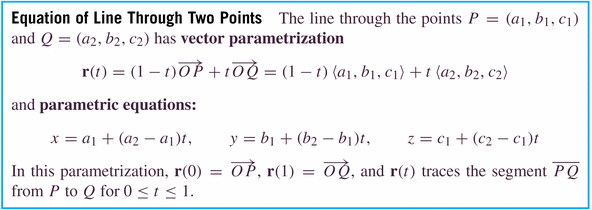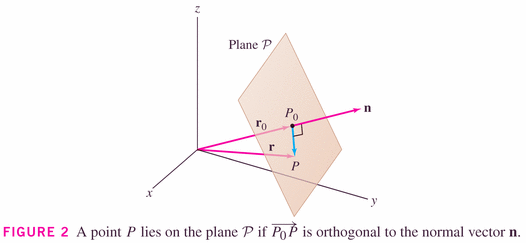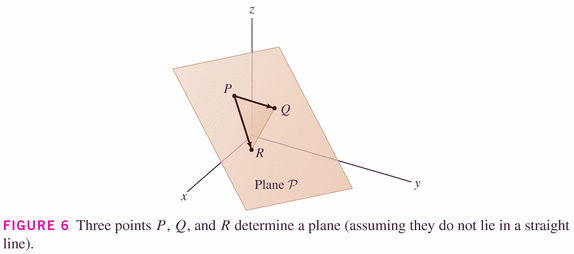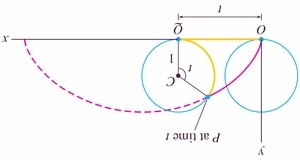- Return of your quiz
- Return of your homework 12.3:
- 20 ("to the nearest degree")
- 30 (Chad)
- 64 (much easier than you thought)
- Last midterm exam on Thursday: it will cover everything from 11.8-11.11, and 12.1-12.3.
- We'll approach this via a worksheet
on lines and planes.
- Parametric Equations of Lines:


- Application of the Cross-Product: Equations of Planes
- We'll start with planes through the origin: general planes
are just displaced versions of these.
Thus, the vectors I discuss in the next few lines can be considered position vectors, originating from the origin.
- The parallelpiped equation

and
: We want to find all vectors
living in the space. Those will be the ones such that
I.e.,
creates a zero volume parallelpiped, because it's living in the plane of
and
.
This gives us our first equation of a plane: if the coordinates of
are given by
and the coordinates of
are given by
(that is
is a normal vector) then the equation becomes
This is one form of the equation of a plane (through the origin). We say that the cross product
is normal to the vectors that live in the plane (or normal to the plane): that is, that it is perpendicular to the plane.
Notice that we can instantly see a normal vector to the vectors in the plane in this form: just pick off the coefficients of the variables (a, b, and c) and turn those into a normal vector.

Now (for the second equation!): notice that
satisfies the equation of the plane
, since
and
are both perpendicular to their cross product. Hence we have another (parametric) equation of a plane (through the origin):
- To offset these planes from the origin, one needs only reinterpret
in the two forms of the equation:
-
which leads to
where
-
which leads to

-
- Examples:
- #3, p. 848
- #13
- #25
- #61
- We'll start with planes through the origin: general planes
are just displaced versions of these.
- And now for something completely different....
A good introduction to parametric curves is given by ballistics. If we shoot a bullet into the air with speed v horizontally, and we neglect all forces but gravity, then the bullet will trace out a parabola (some bullets are larger than others):

Now how might we characterize the path of the bullet? The answer is a parametric curve, of the form C(t)=(x(t), y(t)).
or If we wish, we can solve for t in the equation for x and use that to eliminate the parameter t from the equation for y, hence getting an equation for the parabola traced out: Orbits of planets in the heavens, movements of ants on a hill, a robotic arm in an assembly plant: all these can be described by parametric curves.
- A couple of famous examples involving the cycloid:
- The Brachistochrone Problem (1696, solved by Newton in a single day after he heard the challenge)
- The Tautochrone Problem (1673)
- Parametrizing a line:

- Parametrizing a circle:

- There are two distinctively different kinds of derivatives that
we're going to have to consider here:
- There are the time-derivatives, which give us the actual
speeds of the "particles" as they zip along in time. For the bullet,
the speed will be
- There is the slope of the tangent line to the curve traced
out by the particle, which one can obtain using the time-derivatives:

- There are the time-derivatives, which give us the actual
speeds of the "particles" as they zip along in time. For the bullet,
the speed will be
- One of the most important applications of parametric curves is in
the Bezier curve section. There are lots of important instances
where we need to be able to design custom curves, and this is one of
the most common ways of creating them. For example, you can use them to
create your own "sigmac", using control points. (I had all my
students create their own in numerical analysis.)
- Examples:
- #, p.
